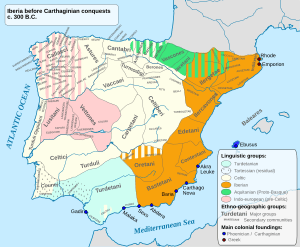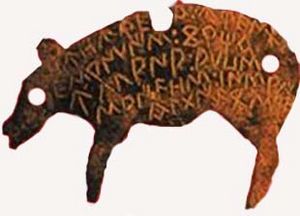Belli facts for kids
The Belli (also called Beli or Belaiscos) were an ancient group of people. They were part of the Celtiberians, who were Celts living in the Iberian Peninsula. The Belli lived in what is now the province of Zaragoza in Spain. They were there long before the Roman Empire became powerful, starting around 300 BC.
Contents
Who Were the Belli?
Roman writers sometimes thought the Belli came from a mix of different groups. They even thought the Belli might be related to the Bellovaci, a Celtic tribe from Gaul. However, we know that the ancestors of the Celtiberian groups, including the Belli, lived in the central part of the Iberian Peninsula much earlier. They were settled there from at least 1000 BC.
Where Did the Belli Live?
The Belli lived in the valleys of the Jiloca and Huerva rivers. These areas are in the Zaragoza province. Their lands also reached towards the Guadalope and upper Turia valleys. They lived close to their neighbors, the Titii.
Their first main city was Segeda. This city is near Poyo de Maya in Zaragoza. Later, their capital moved to Durón de Belmonte. Another important city was Bilbilis, near Calatayud. Other Belli towns included Nertobriga, Contrebia Belaisca, Beligiom, Lesera, and Belgeda. By the 100s BC, they likely controlled other important towns. These included Belia, Osicerda, Damania, and Orosis. These towns faced the Iberian tribes like the Lobetani and Edetani near the coast of Valencia.
What Was Belli Culture Like?
The Belli were one of the most advanced Celtiberian groups. They were the first Celtiberian tribe to start using their own coins. This happened after the 2nd Punic War. They also wrote down their laws on bronze tablets. They used a special writing system called the Celtiberian script. This script was based on an older Iberian writing style.
They also made unique bronze objects called 'hospitality tokens'. These tokens were like identity cards. They were small bronze pieces, split into two halves. Each half was kept by people who had a special friendship or agreement. These tokens helped people travel safely. They also acted as a promise of help. Halves of these tokens have been found hundreds of kilometers apart. This shows that Celtic groups across central Spain had a way to communicate.
One of the most complete Celtiberian texts is from a Belli hospitality token. It says: lubos alisokum aualoske kontebias belaiskas. This means 'Lubos of the Aliso family, son of Aualos, from Contrebia Belaisca'. This shows how people described themselves in Celtic culture. They used their father's name, their family group, and their hometown.
Belli History
During the 200s and 100s BC, the Belli joined the Celtiberian confederacy. This was an alliance with other tribes like the Arevaci, Lusones, and Titii. They worked closely together in politics and war. For example, in 153 BC, the Belli General Caros was chosen to lead the Celtiberian army. This army surprised the Roman leader Quintus Fulvius Nobilior at the Battle of Ribarroya. This battle was at the start of the first Numantine War.
Before that, in 181 BC, the Belli had to accept Roman rule. This was forced upon them by Tiberius Sempronius Gracchus. But this did not stop them from fighting against more Roman expansion. They also fought off raids from other tribes like the Turboletae and the Iberian Lobetani.
Becoming Roman
The Belli were defeated in 143 BC by the Roman general Quintus Caecilius Metellus Macedonicus. Then, the important Celtiberian city of Numantia fell in 133 BC. After this, the Celtiberian confederacy broke apart. The Belli lands became part of the Roman province of Hispania Citerior. We don't know much about their history right after this.
The Belli seemed to stay somewhat independent until the Sertorian Wars in the early 100s BC. During these wars, they slowly lost land to the Edetani tribe. The Edetani took cities like Beligiom, Belgeda, Damania, and Orosis. This meant the Belli lost all their lands east of the Huerva River. Around 72 BC, the Belli and their Titii allies joined with other pro-Roman tribes. These groups formed the Late Celtiberian people. This shows how they gradually became part of the Roman world.
See also
 In Spanish: Bellos para niños
In Spanish: Bellos para niños
- Belgae
- Bellovaci
- Celtiberian confederacy
- Celtiberian script
- Celtiberian Wars
- Illyrians
- Numantine War
- Pre-Roman peoples of the Iberian Peninsula




